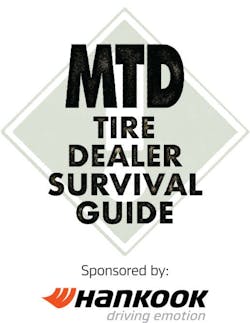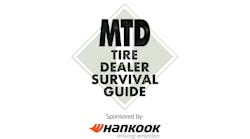A Step-by-Step Guide for Identifying—and Developing—Your Replacement.
By Dennis McCarron
In many independent tire dealerships across the country, the question is being asked: “I’ve been doing this a long time and am ready to retire. Who will step in to carry the torch?”
The answer to that question varies considerably. For some, a son or daughter is the obvious choice. In other cases, a son or daughter may want the top job, but the parents don’t think it’s a good idea. Other owners may have a long-time employee they feel they can trust their business with after they retire. And others understand that when multiple shops are involved—to maximize their retirement—selling to a regional, national or strategic buyer is the logical choice.
And yet others who are not quite ready to retire would like the heavy crown to be lifted and are looking for someone else to simply take over the day-to-day grind of running their business.
Building your leadership pipeline is not a weekend exercise. For many, apprehension around even addressing the concept is the reason that the replacement slot has remained empty or has been left to chance.
To be sure, addressing your current leadership structure and building the next generation of owners can be fraught with hurt feelings and tough conversations. But if an owner wants their “baby” to thrive, they must put in the hard work.
In this column, I will attempt to address as many scenarios as I can and lay out a path for every tire dealership owner—from a single-location dealership to a three- or five-store operation to a large, multi-state operator—with the goal of helping them develop a leadership pipeline that will allow their company to thrive.
If you are an owner who is reluctant to hand over the reins to a son or daughter, take heed. There are a lot of you out there. Whether that child lacks soft skills, vision, financial acumen or is a bump on a log just waiting to take the profits and run, you are not condemned to watch your life’s work crumble. You do, however, need to have a difficult conversation.
If your child expects to be coronated and has shown no interest in learning the ropes or simply can’t grasp the basics, you must have a heart-to-heart talk with them and explain that if their goal is to take over, they must walk a certain path. If they refuse or block attempts at building the pipeline, you still have an obligation to protect the company and your other employees.
In these types of difficult conversations, it is important to prepare and then lay out your argument in logical terms. You must be prepared for the obvious objections and have counter-reasons and alternate solutions.
One way to mitigate the emotional impact of difficult conversations is to avoid what we call “blaming sentences.” Your job here is to avoid sentences that start with the word “You.” Replace that word with the following format: “I + emotion + situation.” For example, you can say, “I am concerned that your lack of involvement in day-to-day activities will be too steep for the company to survive.”
Do not soften your feelings. They are yours to own. Be direct and straightforward, but learn to say it out loud properly in order to reduce the sting. Work through the disagreements where and whenever possible and always have your non-negotiables on the table.
Non-negotiables are those items that no matter what is discussed, cannot be changed. It is far better to have this tough discussion early in the process. If hurt feelings are going to be an inevitable result, then time may heal some wounds.
For those of you who find a way to put a child in your leadership pipeline—whether they agree to committing to the hard work of learning your business or they have been doing so all along—now is the time to develop a strategy to expose them to all facets of the company you have built. As you know, one of the least common, daily things that you personally do is sell tires. Instead, you’re the HR department, the complaint center, the accounts payable person, the marketing guru, the inventory specialist - the list goes on and on. It is vital that your next-in-line is exposed to these - and all - aspects of the business.
For medium-sized dealerships—those with a handful of stores—much of the success in creating a strong leadership pipeline boils down to striking the right blend of outside help and loyal employees. For outside help, it is important to understand the value that someone with external experience can bring to the table. (And make sure that person also aligns with your values.) It also can be a great idea to bring someone in with experience not just in other tire dealerships, but possibly in other industries. Fresh, new ideas require new perspectives. However, fresh faces must also make sure they don’t toss out the tradition and values on which your company was built.
Employees who have risen through the ranks from within should learn early to work with those who bring different views on how to generate sales and profits. Working through differences of opinion while respecting where the business came from can create tension. But tension is good. It forces people to focus on what matters.
However, if the partnership results in stress and isolation, that is bad and will need to be addressed quickly. It is particularly critical for medium-sized businesses to understand the difference between a high-potential performer and a high performer. A high-potential employee is one who exhibits the necessary talents and drive to succeed in their current position and shows glimmers of ability to grow into a job further up the pipeline. A high performer is invaluable to the company at their current position—for example, a top salesperson or a top technician. However, this person doesn’t show the potential to develop the skills required for the next position, whether it be store management or otherwise.
It is imperative that a high performer not be mistaken for a high-potential employee. A high performer who is taken out of their role and put into one they can’t succeed in will not only burn out, but you also will have lost your top dog in that existing spot.
Owners of large dealerships must understand that they aren’t in the tire business. They are in the people business. Managers in large dealerships deal with departments. They deal with strategies and five-year planning. To build a leadership pipeline in this case means that outside people should strongly be considered as a viable option, along with those internal employees who flat-out shine.
In large dealerships, it’s unlikely that a sales advisor or a service technician will have a background in HR or will show an interest in the day-to-day tasks of the various departments that are needed to run a 20-location operation. It’s not impossible and you should continue to look for that diamond, but it’s unlikely you will find that person, especially if you haven’t been grooming people all along.
So what is the process of building a leadership pipeline?
First is an assessment of current potentials within the company and identifying any known gaps, such as positions that will not or cannot be filled internally. Now is the time to be brutally honest about people’s capabilities and who is and isn’t a high-potential player.
Next is setting up a path for those in the pipeline to experience various positions. Internally, it’s time to start those people on rotations in other areas of the company—not so they can master those jobs, but so they can be exposed to how those jobs work and gain empathy for the people that perform those jobs every day.
Leaders do not have to be experts at every job in a company, but they must have the humility and understanding of what it takes to do the job. Externally, it’s time to bring in people who either have the experience or bring them in and exercise them like an internal employee.
When setting up the path, it’s also important to consider exit ramps. All roads do not lead to the president position. The idea of a leadership pipeline is to expose high-potentials to areas within your company and let the process play out. Exit ramps can be placed for store personnel, store management, field operation people and others, depending on the size of your company.
In what order should a pipeline be laid out? First and foremost, anyone with bigger aspirations should have exposure to individual contributors who work front-line jobs. These employees—such technicians, service advisors or delivery drivers—rely on their own skills and judgement to reach goals.
The second stop in the pipeline should be exposure to managers of individual contributors. This area focuses on how well a person does when overseeing individual contributors. Possibly the most important question to ask here is, “Can this person let others be successful for them or do they get frustrated and decide to ‘do the job themselves?’”
The third stop is exposure to a manager of managers. The biggest skill development here is learning to manage from a distance. How well does the manager of managers influence others to the point where they do what they are told without constant oversight?
In larger companies, the next stop is usually exposure to department heads. This is the level where people learn to manage a function of the company, while successfully aligning with other departments. How well do they help support the objectives of other departments?
And finally, for those high-potentials who shine brightly enough to be considered for the top job, find out how well they carry out unpopular decisions, as well as the scope of their vision. Being the top leader in any company requires understanding what is right for the greater good of the business and the ability to focus on a point that is far out in the future. You need someone who can look into the future and accurately assess the threats and opportunities coming in six months or six years. This is who you are now and this is who the person that eventually takes the baton from you should be.
As the top leader within your organization, you have a whole company of people looking at - and working on - the day-to-day stuff. Your job is to chart your dealership’s future course. That includes finding the right person to take the wheel from you when you’re ready to hand it over. Building a strong leadership pipeline will help you accomplish this.
To learn more about Hankook, click here.
This article is part of the MTD Tire Dealer Survival Guide series. More articles in the series can be found below:
Technician Compensation—How To Stay Competitive
How To Make the Most of Every Phone Call



